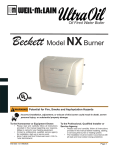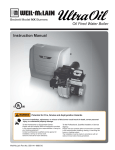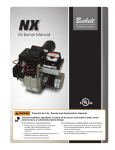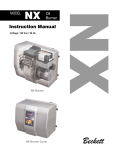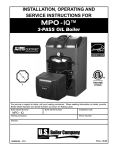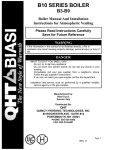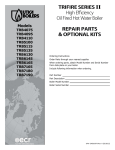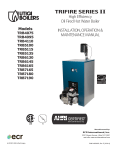Download Weil-McLain CG10 Instruction manual
Transcript
Oil Fired Water Boiler Beckett Model NX Burner ! ! Warning–Notice to Owner Please read and follow all instructions on Page 3 in this manual regarding your responsibilities in caring for your heating equipment Contact a qualified service agency for installation and start-up. Incorrect Installation, adjustment, or misuse of this burner could result in severe personal injury, death or substantial property damage. S119 WM 550-141-996/1105 RWB 6104WMNX R1005 Warning–To Professional Installer or Service Provider Please read and follow all instructions contained in this manual before installing, starting or servicing this heating system. Incorrect Installation, adjustment, or misuse of this burner could result in severe personal injury, death or substantial property damage. S120 Page 1 Table of Contents Hazard Definitions and Owner’s Information ........................................................................................ 3 Information To Be Used Only By Qualified Service Technicians Weil McLain Burner Specification .............................................................................................................. 4 General Information ......................................................................................................................................... 5 Certifications/Approvals………………………………………………………….................................................... 5 Notice Special Requirements ........................................................................................................................... 6 Inspect/Prepare Installation Site................................................................................................................. 7 Clearances to Burner and Appliance............................................................................................................... 7 Inspect Chimney or Direct Vent System ......................................................................................................... 7 Combustion Air Supply..................................................................................................................................... 7 Safety Shutoff for Direct Vent System............................................................................................................. 7 Direct/Sidewall Venting Application ................................................................................................................ 7 Fuel Line Installation......................................................................................................................................... 8 Fuel Line Valves and Filters ............................................................................................................................. 8 System Wiring .................................................................................................................................................. 8 Prepare the Burner ........................................................................................................................................... 9 General ......................................................................................................................................................... 9 Mount Burner on Appliance ............................................................................................................................. 9 Connect Fuel Lines ........................................................................................................................................... 9 Wiring Connection Diagram ............................................................................................................................. 9 Start the Burner and Set Combustion .................................................................................................... 12 Start-up and Initial Settings............................................................................................................................ 12 Set Combustion with Test Instruments ......................................................................................................... 13 Cover Installation ............................................................................................................................................ 13 Trained Service Technician’s Regular Maintenance ......................................................................... 14 Removing Nozzle Line for Service................................................................................................................. 14 Nozzle Installation ........................................................................................................................................... 15 Check/Adjust Electrodes ................................................................................................................................ 16 Check Retention Head Alignment and Cad Cell Sighting............................................................................ 16 Check/Adjust “Zero” Calibration ................................................................................................................... 16 Blower Wheel Replacement ........................................................................................................................... 17 Replacement Parts Diagram ....................................................................................................................... 18 Replacement Parts Diagram........................................................................................................................... 18 Replacement Parts List................................................................................................................................... 19 Beckett Limited Warranty Information ................................................................................................... 20 Page 2 WM 550-141-996/1105 RWB 6104WMNX R1005 General Information Hazard Definitions ! To the Owner: Thank you for purchasing a Beckett NX burner Danger–Designation Denotes presence of a hazard which, if ignored, will result in death, severe personal injury, and/or substantial property damage. Death, personal Injury, and/or substantial property damage S118 ! Warning–Designation Your NX burner will provide years of efficient operation if it is professionally installed and maintained by a qualified service technician. If at any time the burner does not appear to be operating properly, immediately contact your qualified service agency for consultation. We recommend annual inspection/service of your oil heating system by a qualified service agency. Denotes presence of a hazard which, if ignored, could result in death, severe personal injury, and/or substantial property damage. Death, personal Injury, and/or substantial property damage S103 ! for use with your heating appliance. Please pay attention to the Safety Warnings contained within this instruction manual. Keep this manual for your records and provide it to your qualified service agency for use in professionally setting up and maintaining your NX burner. Caution–Designation Denotes presence of a hazard which, if ignored, could result in personal injury and/or property damage. Denotes presence of a hazard which, if ignored, could result in personal injury and/or property damage S102 Daily – Check the room in which your burner/appliance is installed. Make sure: • Air ventilation openings are clean and unobstructed • Nothing is blocking burner inlet air openings • No combustible materials are stored near the heating appliance • There are no signs of oil or water leaking around the burner or appliance Weekly • Check your oil tank level. Always keep your oil tank full, especially during the summer, in order to prevent condensation of moisture on the inside surface of the tank. ! Warning – Owner’s Responsibilty Contact a professional, qualified service agency for the installation, adjustment and service of your oil heating system. This work requires technical training, trade experience and the proper use of special combustion test instruments. NOTICE Intended to bring special attention to information, but not related to personal injury or property damage. Please carefully read and comply with the following instructions: Never store gasoline or combustible materials near this burner or appliance. Never attempt to burn garbage or refuse in this appliance. Never attempt to light the burner/appliance by throwing burning material into the appliance. Never attempt to use gasoline, crankcase, waste oil, or other fuels not approved for use in this burner. Never restrict the air inlet openings to the burner or the combustion air ventilation openings in the room. Incorrect installation, adjustment, and use of this burner could result in severe personal injury death, or substantial property damage from fire, carbon monoxide poisoning, soot or explosion. S101 WM 550-141-996/1105 RWB 6104WMNX R1005 Page 3 Weil-McLain Burner Specifications NOTICE The remainder of this manual contains Information to be used ONLY by a qualified Service Technician. NX Burner Specifications for Weil-McLain Ultra Oil Boilers Verify that burner specification number (on burner carton) and configuration agrees with information below. Table 1. Burner Configurations The table below provides burner specifications and starting air settings for NX burners applied to Weil-McLain Model UO boilers. Follow all instructions in this burner manual, the boiler manual and the fuel pump literature to install, setup and service the burner. Boiler Model UO-3 CV Burner Spec Firing Rate (GPH) Air Tube Combination Insertion Primary Nozzle Alternate Nozzle Fuel Pump Pressure (psig) Head/ Air Adjustment Plate Setting WL5703 0.80 NX70LC 1-3/4” 0.65 X 60oA Delavan 0.65 X 70oB Hago 150 1.75 (See Note1) UO-3 CV WL5703 1.00 NX70LC 1-3/4” 0.75 X 60oB Hago 0.75 X 60oB Delavan 175 2.50 UO-4 CV WL5704 1.20 NX90LB 3-1/2” 1.00 X 70oB Hago 1.00 X 70oB Delavan 140 4.00 UO-5 CV WL5705 1.40 NX90LD 3-1/2” 1.10 X 70oB Hago 1.10 X 70oB Delavan 160 1.50 WL5803 0.80 NX70LC 1-3/4” 0.65 X 60oA Delavan 0.65 X 70oB Hago 150 1.75 UO-3 DV (See Note1) UO-3 DV WL5803 1.00 NX70LC 1-3/4” 0.75 X 60oB Hago 0.75 X 60oB Delavan 175 2.50 UO-4 DV WL5804 1.20 NX90LB 3-1/2” 1.00 X 70oB Hago 1.00 X 70oB Delavan 140 4.00 UO-5 DV WL5805 1.40 NX90LD 3-1/2” 1.10 X 70oB Hago 1.10 X 70oB Delavan 160 1.50 1) Shipped as 1.0 GPH Burner Configuration. The 0.80 GPH input uses same burner as 1.0 GPH input. Replace nozzle, adjust pump pressure and Head/Air setting as shown above and install 14”x16” blanket on combustion chamber floor. (See Maintenance Section for Nozzle Replacement details.) Page 4 WM 550-141-996/1105 RWB 6104WMNX R1005 General Specifications General Specifications ! Table 2 – Burner Specifications Capacity LB & LC Firing rate 0.40 – 1.35 GPH Input 56,000 – 189,000 Btu This equipment must be installed, adjusted and put into operation only by a qualified individual or service agency that is: x Licensed or certified to install and provide technical service to oil heating systems. x Experienced with all applicable codes, standards and ordinances x Responsible for the correct installation and commission of this equipment x Skilled in the adjustment of oil burners using combustion test instruments. LD & LF Firing rate 1.10 - 1.75 GPH Input 154,000 – 245,000 Btu/h Fuels U. S No. 1 or No. 2 heating oil only ...........(ASTM D396) Canada No. 1 stove oil or No. 2 .........furnace oil only Electrical The installation must strictly comply with all applicable codes, authorities having jurisdiction and the latest revision of the National Fire Protection Association Standard for the Installation of Oil-Burning Equipment, NFPA 31 (or CSA B139 and B140 in Canada). Power supply 120 volts AC, 60 Hz, .............single phase Operating load 5.8 Amps max Motor 1/7 hp, 3450 rpm, NEMA 48M frame PSC rotation CCW when facing shaft end Ignition Continuous duty solid-state igniter Fuel pump Outlet pressure ...... Note 1 Air tube ATC code .......See Table 3 Dimensions (with cover) Height (maximum) 12-1/2 inches Width (maximum) 15 inches Depth ............ 9-1/4 inches Air tube diameter 3-1/4 inches Warning–Professional Service Required Regulation by these authorities take precedence over the general instructions provided in this installation manual. Read and understand the manual supplied with this equipment. Incorrect installation, adjustment, and use of this burner may result in severe personal injury death, or substantial property damage from fire, carbon monoxide poisoning, soot or explosion. Note 1. See appliance manufacturer’s burner specifications for recommended outlet pressure. Table 3 – Air Tube Combination (ATC) codes Firing rate (gph) Head (min-max) ATC codes for usable air tube lengths: 5” 7” 9” 0.40-1.35 9-Slot NX50LB NX70LB NX90LB 0.40-1.35 6-Slot NX50LC NX70LC NX90LC 1.10-1.75 9-Slot NX50LD NX70LD NX90LD 1.10-1.75 6-Slot NX50LF NX70LF NX90LF WM 550-141-996/1105 RWB 6104WMNX R1005 S105 • Certifications/approvals Underwriters Laboratories has certified this burner to comply with ANSI/UL 296 and has listed it for use with #1 or #2 fuel oil as specified in ASTM D396. Low sulfur #1 and #2 fuel oils reduce heat exchanger deposits with all burners compared to the standard fuels. Reduced deposits extend the service interval for cleaning and improve the efficiency of the appliance over time. Low sulfur fuels reduce particulate and oxides of nitrogen emissions as well. The Oilheat Manufacturers’ Association recommends these fuels as the preferred fuels for this burner. Page 5 General Specifications • Notice Special Requirements State and local approvals are shown on burner rating label mounted on the burner housing. For recommended installation practice in Canada, refer to the latest version of CSA Standard B139 & B140. Concealed damage — If you discover damage to the burner or controls during unpacking, notify the carrier at once and file the appropriate claim. When contacting Beckett for service information — Please record the burner serial number (and have available when calling or writing). You will find the serial number on the silver label located on the left rear of the burner. Refer to Figure 1. Figure 1. Burner label location Page 6 WM 550-141-996/1105 RWB 6104WMNX R1005 Site Preparation Inspect/Prepare Installation Site • Clearances to Burner and Appliance Provide space around burner and appliance for ease of service and maintenance. Check the minimum clearances against those shown by the appliance manufacturer and by applicable building codes. • Inspect Chimney or Direct Vent System Inspect the chimney or vent. Make sure it is properly sized and in good working condition. Follow the instructions supplied by the appliance manufacturer. Exhaust fans and other air-using devices: Size air openings large enough to supply all air-using devices in addition to the minimum size required for combustion air. If there is any possibility of the equipment room developing a negative pressure due to exhaust fans, clothes dryers, etc., either pipe combustion air directly to the burner or provide a sealed enclosure for the burner and supply it with its own combustion air supply. • Safety Shutoff for Direct Vent System • Combustion Air Supply Information ! one near the bottom of the enclosure. Each opening must have a free area of not less than one (1) square inch per 1,000 BTU’s per hour of the total input rating of all appliances within the enclosure. The openings should have free access to the building interior, which should have adequate infiltration from the outside. The direct vent blocked flue safety shut off system, refer to Figure 2, shuts down the burner if the exhaust flue is blocked and/or if the air inlet is blocked. It recognizes a blocked flue by sensing excessive pressure in the combustion chamber. It recognizes a blocked inlet by sensing excessive vacuum in the air inlet adapter. Warning–Adequate Air Supply Required The burner cannot properly burn the fuel if it is not supplied with a reliable combustion air source. A non-reliable air source could result in incomplete combustion, causing sooting and possible carbon monoxide emission. Possible Sooting & Asphyxiation Hazard S104 See NFPA Standard 31 for complete details. Appliances located in confined spaces: All confined spaces should have two (2) permanent openings; one near the top of the enclosure and This system meets the requirements for a blocked flue or blocked combustion air inlet per CSA Standard B140.0. It is designed to interrupt the cad cell circuit and allow the control to shut down the burner. • Direct/Sidewall Venting Application For direct vent installations, follow instructions provided with appliance and direct vent system. Outside combustion air is required for direct venting. Figure 2. Pressure Switch Installation SK9803A WM 550-141-996/1105 RWB 6104WMNX R1005 Page 7 Site Preparation ! • Fuel Line Valves and Filter Warning–Connect Outside Air Duct to NX Adapter. The outside air adapter must be installed by strictly following the kit installation instructions. Do NOT attempt to install outside air piping without using the outside air adapter and instructions provided. Abundant fresh air is required for proper combustion. Failure to install adapter properly could result in impaired combustion, appliance soot-up, puffback of smoke, and fire or asphyxiation hazards. S121 When installing an NX outside air adapter (Beckett Part Number 5199OU), refer to the instruction sheet supplied with the adapter. This kit allows combustion air to be piped directly to the burner. The NX outside air adapter kit may also be used for chimney vent applications that require outside combustion air. Install two high quality oil duty rated shutoff valves in accessible locations on the oil supply line. Locate one close to the tank and the other close to the burner, upstream of the filter. Also install a generous capacity filter, rated for 50 microns or less, inside the building between the fuel tank shutoff valve and the burner. Locate both the filter and the valve close to the burner for ease of servicing. NOTICE For protection in the event of fire, some states require the shutoff valves to be a fusible-handle design. R.W. Beckett Corporation recommends this design as good industry practice for all installations. • System Wiring • Fuel Line Installation Route the fuel line through the opening in the bottom of the burner cover. Continuous lengths of heavy wall copper tubing are recommended. Always use flare fittings. Never use compression fittings. Refer to appliance manufacturer’s wiring diagram for electrical connections. Always install fittings in accessible locations. To avoid vibration noise, fuel lines should not run against the appliance or ceiling joists. ! Caution–Do Not Use Teflon Tape Never use Teflon tape on any fuel fitting. Tape fragments can lodge in fuel line components and fuel unit, damaging the equipment and preventing proper operation. Damage to the Pump could cause impaired burner operation, oil leakage and appliance soot-up. S111 Page 8 WM 550-141-996/1105 RWB 6104WMNX R1005 Burner Preparation Prepare the Burner ! • General In most cases, the burner is ready to mount to the appliance. There can be situations where the burner needs to be reconfigured to perform properly in the appliance. Review the appliance manufacturer’s specifications prior to installing to determine if any modification is required to properly configure the burner. Refer to Table 1. Instruction on how to perform the following burner preparation tasks can be found in the Professional Maintenance section. • Remove / install burner nozzle • Check head/air adjusting plate • Mount Burner on Appliance Verify that the air tube installed on the burner provides the correct insertion depth. Bolt the burner to the appliance using the factory-welded flange. Note that the end of the tube will extend into the chamber on UO-4 and UO-5 boilers. • Connect Fuel Lines The burner is supplied with either a one-stage pump or a two-stage pump based on the oil supply system requirements. Consult the instructions provided with the pump for installation specifications. Caution–Oil Supply ! Pressure Control Required The oil supply inlet pressure to the fuel unit cannot exceed 3 psi. Insure that a pressure-limiting device is installed in accordance with the latest edition of the NFPA 31. Damage to Pump Seal could cause possible oil leakage and potential fire hazard. Warning – By-pass Plug in 2 Pipe System The burner pump is shipped without the by-pass plug installed. You must install this plug on two-pipe oil systems. If the unit is a one-pipe oil system DO NOT install the plug in the pump. Failure to comply could cause pump seal failure, oil leakage and the potential for a fire and injury hazard. S110 When installing a two-pipe system, remove the 1/16” pipe by-pass plug from plastic bag attached to fuel unit. Remove ¼” plug from return port. Insert and tighten the by-pass plug. Attach return and inlet lines. Start burner. Air bleeding is automatic. Open the easy flow air bleed valve for a faster bleed, if desired. The return line should terminate approximately 3-4” above supply line inlet. Failure to do this may introduce air into the system and could result in loss of prime. • Wiring Connection Diagram Burner wiring performed at jobsite: Refer to Figure 3, for typical burner interconnect wiring, Burner wiring may vary, depending on the burner specification. Refer to Figure 4 for burner wiring details. All wiring must be in accordance with the latest revision of National Electric Code NFPA 70 and all local codes and regulations. The R7184 primary control with valve-on delay and burner motor-off delay, shown in Figure 4, requires a constant 120 volt AC power source supplied to the black wire on the control. The red wire goes to the appliance limit circuit. Please note that other control manufacturers may use different wire colors for power and limit connections. S109 When installing a one-pipe system, connect the inlet line to the pump inlet. Start the burner. Arrange the primary burner control for continuous operation during priming by pressing the control reset button during prepurge. Open the bleed valve one turn counterclockwise. Prime the system until all air bubbles have disappeared. Tighten the bleed valve securely. The fuel pump may be installed with gravity feed or lift. The maximum allowable lift for a single pipe installation is 8 ft. WM 550-141-996/1105 RWB 6104WMNX R1005 NOTICE The NX burner has a reduced diameter air tube, precision-designed air throttle cup and combustion head for improved performance. This design provides very accurate control of the air/fuel ratio, but the light reaching the cad cell through small holes in these components is limited. Because of this, the average cad cell resistance may be higher than conventional burners with larger openings. Page 9 Burner Preparation Figure 3. – Burner Connections. SK9806 Page 10 WM 550-141-996/1105 RWB 6104WMNX R1005 Burner Preparation Figure 4. – Typical Burner Wiring & Burner Sequence of Operation BURNER JUNCTION BOX R7184P Primary Control R BK W W W W V SOLENOID VALVE R BK BL/W O G W IGNITOR LIMIT L1 L2 L2 L2 L2 VALVE IGNITOR R 1 2 3/T BK W T MOTOR Y Y BURNER PRIMARY CONTROL BURNER MOTOR SEE BOILER INSTRUCTION MANUAL FOR CORRECT WIRING CAD CELL BURNER DISCONNECTS PRESSURE SWITCH (DIRECT VENT ONLY) SK9805 120 VAC FIELD WIRING LOW VOLTAGE FIELD WIRING 120 VAC FACTORY WIRING LOW VOLTAGE FACTORY WIRING 1. STANDBY. The burner is idle, waiting for a call for heat. When a call for heat is initiated, there is a 2-6 second delay while the control performs a safe start check. 2. VALVE-ON DELAY. The ignition and motor are turned on for a 15 second valve-on delay. 3. TRIAL FOR IGNITION (TFI). The fuel valve is opened. A flame should be established within the 15 second lockout time. 4. LOCKOUT. If flame is not sensed by the end of the TFI, the control shuts down on safety lockout and must be manually reset. If the control locks out three times in a row, the control enters restricted lockout. 5. IGNITION CARRYOVER. Once flame is established, the ignition remains on for 10 seconds to ensure flame stability before turning off. If the control is wired for intermittent duty ignition, the ignition unit stays on the entire time the motor is running. 6. RUN. The burner runs until the call for heat is satified. The burner is then sent to burner motor off delay, if applicable, or it is shut down and sent to standby. 7. RECYCLE. If the flame is lost while the burner is firing, the control shuts down the burner, enters a 60 second recycle delay, and then repeats the above WM 550-141-996/1105 RWB 6104WMNX R1005 Electrical shock hazard — can cause severe injury or death. Disconnect power before installing or servicing. Burners with Beckett Clean Cut Pump must be used with a primary control that has a valve-on delay (pre-purge). Controls shown have valve on delay (see control manufacturer’s instructions for timings.) ignition sequence. If flame is lost three times in a row, the control locks out to prevent cycling with repetitious flame loss due to poor combustion. 8. BURNER MOTOR-OFF DELAY. The fuel valve is closed and the burner motor is kept on for the selected motor-off delay time before the control returns the burner to standby. 61351 Page 11 Start the Burner Start the Burner and Set Combustion • Start-up and Initial Settings 1. Open the shutoff valves in the oil supply line to the burner. 2. Referencing Figure 5 verify and/or set the Head/ Air Adjustment Pointer to the value shown in Table 1. This is an initial air setting for the pump bleeding procedure only. Calibrated test instruments must be used for the final head/air adjustment. 3. Set the thermostat substantially above room temperature. 4. Close the line voltage switch to start the burner. If the burner does not start within the 3 to 10 second safety start check timing, you may have to reset the safety switch on the burner primary control. 5. Bleed the air from the fuel pump as soon as the burner motor begins rotating. ! Warning–Professional Service Required This equipment must be installed, adjusted and put into operation only by a qualified individual or service agency that is: x Licensed or certified to install and provide technical service to oil heating systems. x Experienced with all applicable codes, standards and ordinances x Responsible for the correct installation and commission of this equipment x Skilled in the adjustment of oil burners using combustion test instruments. The installation must strictly comply with all applicable codes, authorities having jurisdiction and the latest revision of the National Fire Protection Association Standard for the Installation of Oil-Burning Equipment, NFPA 31 (or CSA B139 and B140 in Canada). Step 1: To bleed the fuel pump, attach a clear plastic hose over the vent fitting. Loosen the fitting and catch the oil in an empty container. Tighten the fitting when all the air has been purged from the oil supply system. Step 2: If the burner locks-out on safety during bleeding, reset the safety switch and complete the bleeding procedure. Note — For R7184 primary controls, see Technician’s Quick Reference Guide, part number 61351 or 61465, for special pump priming sequence. Step 3: If the burner stops after a flame is established, additional bleeding is probably required. Repeat the bleeding procedure until the pump is primed and a flame is established when the vent fitting is closed. 6. Prepare for combustion tests by drilling a 1/4” sampling hole in the flue pipe between the appliance and the barometric draft regulator. Seal this hole when testing is complete. (See appliance manufacturer for location.) 7. Loosen the splined nut approximately one turn. (DO NOT loosen the upper acorn nut. This is used only for setting the zero adjustment.) (See Figure 5.) 8. A 5/16” nut driver or flat blade screwdriver can be used to turn the adjustment screw for head/air setting. Figure 5. – Head/air Adjustment Plate Assembly Scale Regulation by these authorities take precedence over the general instructions provided in this installation manual. Read and understand the manual supplied with this equipment. Incorrect installation, adjustment, and use of this burner may result in severe personal injury death, or substantial property damage from fire, carbon monoxide poisoning, soot or explosion. Upper Acorn Nut (Lock Zero Calibration) Pointer Splined Nut Adjustment Nut Lower Acorn Nut (Lock Air Setting) SK9667 S105 Page 12 WM 550-141-996/1105 RWB 6104WMNX R1005 Start the Burner ! Warning–Check for Excess Fuel Accumulation. Do not attempt to start the burner when excess fuel or vapor has accumulated in the appliance. Starting the burner under these conditions could result in a puffback of hot combustion gases, high smoke levels, or otherwise hazardous operation. Could cause death, personal injury and/or substantial property damage due to equipment malfunction, heavy smoke, soot blockage, hot gas puff-back, fire and asphyxiation hazard. S112 • Set Combustion with Test Instruments 1. Allow the burner to run for approximately 5 to 10 minutes. 2. Set the stack draft between -0.01” to -0.02” w.c. for chimney vent applications. No draft adjustment required for direct venting. 4. Chimney Vent Systems: Install the burner cover and repeat Steps 2 and 4 above. If CO2 increases (O2 decreases), remove the cover and adjust the air setting so the CO2 (O2) with the cover installed meets the requirements of Step 3. 5. Direct Vent Systems with Outside Air Ducted to Burner: Install the burner cover. 6. Start and stop the burner several times to ensure satisfactory operation. Test the primary control and all other appliance safety controls to verify that they function according to the manufacturer’s specifications. • Cover Installation 1. Install the cover mounting screws in the cover mounting plate. 2. Install the cover over the mounting plate while aligning the side slots with the installed cover mounting screws. 3. Direct Vent specified burners include an opening on the top of the cover for an outside air intake. 3. Follow these five steps to properly adjust the burner: Step 1: Adjust the head/air until a trace of smoke is achieved. This can be accomplished by turning the screw on the head/air adjustment plate assembly to increase air (CCW) or decrease air (CW). Figure 6. – Burner Cover Step 2: At the trace of smoke level, measure the CO2 (or O2) . This is the vital reference point for further adjustments. Example: 13.5% CO2 (2.6% O2) Step 3: Increase the air to reduce the CO2 by 1.5 to 2 percentage points. (O2 will be increased by approximately 2.0 to 2.7 percentage points.) Example: Reduce CO2 from 13.5% to 11.5% (2.6% to 5.3% O2). Step 4: Recheck smoke level. It should be Zero. • This procedure provides a margin of reserve air to accommodate variable conditions. • If the draft level has changed, recheck the smoke and CO2 levels and readjust burner, if necessary. SK9804A Step 5: Once the combustion has been set, tighten the lower acorn nut and splined nut on the air adjustment assembly. See Figure 5. WM 550-141-996/1105 RWB 6104WMNX R1005 Page 13 Professional Maintenance Trained Service Technician’s Regular Maintenance While performing routine maintenance check the following. Replace the oil supply line filter. The line filter cartridge must be replaced to avoid contamination of the fuel pump and nozzle. • Inspect the oil supply system. All fittings should be tight and leak-free. The supply lines should be free of water, sludge and other restrictions. • Remove and clean the pump strainer if applicable. • Replace the used nozzle with a new nozzle per appliance manufacturer’s specifications. • Clean and inspect the electrodes for damage, replacing any that are cracked or chipped. • Check electrode tip settings. Replace electrodes if tips are rounded. • Inspect the igniter spring contacts. • Clean the cad cell grid surface, if necessary. • Make sure Low Firing Rate Baffle is in place if required for the burner application. Omitting the baffle can result in unacceptable burner combustion. • Inspect all gaskets. Replace any that are damaged or would fail to seal adequately. • Clean the blower wheel, air inlet, air guide, retention head, throttle plate and throttle ring of any lint or foreign material. • Check motor current. The amp draw should not exceed the nameplate rating by more than 10%. • Check all wiring for secure connections or insulation breaks. • Check the pump pressure and cutoff function. • Check primary control safety lockout timing. • Check ignition system for proper operation. • Inspect the vent system and chimney for soot accumulation or other restriction. • Clean the appliance thoroughly according to the manufacturer’s recommendations. • Check the burner performance. Refer to the section “Set combustion with test instruments”. • It is good practice to keep a record of the service performed and the combustion test results. • ! Warning–Professional Service Required This equipment must be installed, adjusted and put into operation only by a qualified individual or service agency that is: x Licensed or certified to install and provide technical service to oil heating systems. x Experienced with all applicable codes, standards and ordinances x Responsible for the correct installation and commission of this equipment x Skilled in the adjustment of oil burners using combustion test instruments. The installation must strictly comply with all applicable codes, authorities having jurisdiction and the latest revision of the National Fire Protection Association Standard for the Installation of Oil-Burning Equipment, NFPA 31 (or CSA B139 and B140 in Canada). Regulation by these authorities take precedence over the general instructions provided in this installation manual. Read and understand the manual supplied with this equipment. Incorrect installation, adjustment, and use of this burner may result in severe personal injury death, or substantial property damage from fire, carbon monoxide poisoning, soot or explosion. S105 3. Disconnect the copper connector tube assembly from the nozzle line bulkhead fitting. 4. Loosen the two screws securing the igniter retaining clips and rotate both clips to release the igniter baseplate. The igniter should pop up and be supported by the prop spring. 5. Loosen the two screws securing the rear door. Swing the door to the right and down 6. Loosen the splined nut. 1. Before proceeding, turn off the main power switch to the burner. 7. Remove the nozzle line electrode and head assembly from the burner by drawing it straight back and out the rear door opening. The adjustment mechanism is still attached. Be careful not to damage the electrodes or insulators while handling. 2. Remove the burner cover by loosening the four thumb screws (two on each side of burner). 8. To replace the nozzle assembly, reverse the above procedure. Removing Nozzle Line for Service (Reference the Replacement Parts drawing.) Page 14 WM 550-141-996/1105 RWB 6104WMNX R1005 Professional Maintenance • Nozzle Installation Obtain a nozzle having the capacity, spray angle, and pattern specified in the appliance manufacturer’s information or Beckett OEM Specification Guide, Part # 6711. Make certain the correct nozzle is selected for the actual fuel pump pressure. See Table 1. Perform the following steps when replacing a nozzle. 1. Remove the nozzle line assembly to gain access to the nozzle. 6. Protect the nozzle orifice and strainer when installing. If the orifice gets dirt in it or is scratched, the nozzle will not function properly. 7. To install a new nozzle, place a ¾” open-end wrench on the nozzle adapter. Insert the nozzle into the adapter and secure finger tight. Finish tightening with a ⅝” open-end wrench. Use care to avoid bending the burner head support legs or electrodes. Figure 7. – Electrode tip gap and spacing 5/32” GAP 1/4” above nozzle center 2. Use a ¾” open-end wrench to hold the nozzle adapter. DO NOT attempt to remove or replace the nozzle without securing the adapter, as nozzle alignment could be seriously affected. 3. Do not squeeze the electrodes when handling the nozzle line assembly. Excessive force could change the electrode tip settings or damage the ceramic electrode insulators. 4. Use a 5/8” open-end wrench to carefully remove the existing nozzle. 5. Inspect the nozzle adapter before installing the new nozzle. If it is grooved or scratched on the sealing surface, replace the nozzle line assembly. If the surface is damaged, oil could leak at the nozzle to adapter joint, causing serious combustion problems. 3/32” Nozzle-to-tip Spacing SK9664 8. Do not over-torque the nozzle when installing. This will cause deep grooves in the nozzle adapter, preventing a seal when a new nozzle is installed. 9. Carefully check and realign the electrode tips after replacing a nozzle, ensuring the electrode settings comply with Figure 7. 10. If the head was removed when replacing the nozzle, carefully reconnect the head to the nozzle adapter. Make sure to align the key in the support leg with the keyway in the nozzle adapter and to butt the head support to the nozzle adapter shoulder, see Figure 8. Figure 8. – Nozzle Line/Head/Air Tube Assembly (Low firing rate shown.) Retention Head Head Support Legs Electrode Tips Electrode Clamp Electrode Bracket Electrode Insulator Electrode Extension Rods SK9666A Bulkhead Fitting Nozzle Line Nozzle Adapter Nozzle Stops in Retention Ring Retention Ring WM 550-141-996/1105 RWB 6104WMNX R1005 Throttle Ring Throttle Cup SK9666A Page 15 Professional Maintenance • Check the electrode tip settings, as shown in Figure 7. If necessary, adjust by loosening the electrode clamp screw (Figure 8) and slide/rotate the electrodes as necessary. When the adjustment is complete, securely tighten the clamp screw. • Check Retention Head Alignment and Cad Cell Sighting (Refer to Figure 9.) The cad cell sighting holes in both the throttle cup and the retention head must be aligned to allow the cad cell to detect the flame. Make sure the stamped key in the retention head collar lines up with the keyway in the nozzle adapter when mounting the retention head. NOTICE The NX burner has a reduced diameter air tube, precision-designed air throttle cup and combustion head for improved performance. This design provides very accurate control of the air/fuel ratio, but the light reaching the cad cell through small holes in these components is limited. Because of this, the average cad cell resistance may be higher than conventional burners with larger openings. • If the zero calibration has not been set, perform the following procedure: Check/Adjust Electrodes Check/Adjust “Zero” Calibration 1. Install the nozzle line, with the adjustment plate assembly attached, into the burner. 2. Install and tighten the rear door to hold the air adjustment plate assembly in position. 3. Slightly loosen the upper acorn nut, the splined nut, and the lower acorn nut. 4. Turn the air adjustment screw clockwise to adjust the plate with the pointer to the zero position. 5. Referring to Figure 8, slide the nozzle line assembly forward until the retention head engages the fixed stops in the retention ring at the end of the air tube. 6. Tighten the upper acorn nut securely. 7. The rear door must be kept tightly closed. The adjustment screw may now be turned to adjust the head/air setting. 8. Turn the adjusting screw to a setting ½ number lower than the proper set point as indicated in Table 1. Then turn the adjusting screw counterclockwise to the proper setting. 9. Tighten the splined nut and lower acorn nut after the head/air setting has been adjusted. On burners with factory-installed air tubes, the zero calibration has been factory set. Make sure the retention head (Figure 8) is securely against the stops in the retention ring when the adjustment plate pointer is at “0” (Figure 5). Figure 9 – Retention Head/Throttle Cup Alignment SK9665 Page 16 WM 550-141-996/1105 RWB 6104WMNX R1005 Professional Maintenance • Blower Wheel Replacement For installation or replacement of a blower wheel, insure that there is a space between the blower wheel and the motor face of 0.115”. Refer to Figure 10. Figure 10. – Blower wheel assembly SK9670 WM 550-141-996/1105 RWB 6104WMNX R1005 Page 17 Professional Maintenance Replacement Parts Diagram SK967102 SK9804B For best performance specify genuine Page 18 Beckett SK9803B replacement parts WM 550-141-996/1105 RWB 6104WMNX R1005 Professional Maintenance Part Number designations for Replacement Parts Diagrams on Page 18. Item Description Part No. 17 Inlet air louvers 1013U 1 Head/Air adjustment mechanism assembly 51794U 19 Nozzle Line Electrode and Head Assembly Specify 2 Air guide 101101U 20 3 Gasket, mounting flange (not shown) 32389 PSC Motor, (Requires Mounting screws ¼ -20 x 7/8”) 21805U 4189 4 Air tube combination, (Includes Screws, air tube mounting #8 x 3/8) Specify 4396 21 Primary control R7184P Valve-on/Motor Delay R7184P With Alarm Contacts 5 Blower wheel 2999U 22 51785U 6 Connector tube assembly, 11” 51127 Retention head assembly, 6 -slot 7 Coupling 2454 23 51815U 8 Door, rear access 32119U Retention head assembly, 9 -slot 9 Electrode insulator kit 51811U 24 Splined nut 3666 10 CleanCut Fuel Pump, (Requires Mounting Screws ¼ -20 x 7/8”) 2184404U 4189 25 Spring, igniter prop 32058U 26 Electrical box 5770 28 Cover, burner 32395U 11a Gasket, igniter baseplate 51942U 29 Mounting plate, burner cover 32399U 11b Gasket, igniter baseplate hinge 51942U 30 Thumbscrews, cover mounting 21899U 11c Gasket, wiring 51942U 31* 21895U 11d Gasket, rear access door 51942U Pressure Switch Kit, including switch, (2) hoses & pressure switch/cad cell lead 15 Igniter, electronic 51771U 32* 5199OU 16 Inlet air box 1010U Air adapter w/Pressure Port & Trim Plate 33* Parts kit, Including (2) hoses & pressure switch/cad cell lead 51988U 7457U 7458U * Denotes an optional part per burner specification. For best performance specify genuine WM 550-141-996/1105 RWB 6104WMNX R1005 Beckett replacement parts Page 19 Limited WARRANTY For Residential, Commercial and Specialty Burners The R. W. BECKETT CORPORATION (“Beckett”) warrants to persons who purchase its Beckett burners from Beckett for resale or for incorporation into a product for resale (“Customers”) that its equipment is free from defects in material and workmanship under normal use and service for 60 months from the date of manufacture for Residential Burners and 18 months from the date of manufacture for Commercial and Specialty Burners. Residential burner models include: AF, AFG, AFII, NX, SF, SR and SMG. Commercial burner models include: CF375, CF500, CF800, CF1400, CF2300A, CF2500, CF3500A, CG10, CG15, CG25 and CG50. Specialty burner models include: ADC, ADCP, ARV, SDC and SM. The provisions of this warranty are extended to individual major burner components as follows: a) 60 months from date of manufacture for all Beckett-branded major components, except for 12 Vdc components. b) 18 months from date of manufacture for all non-Beckett-branded major components and Beckett branded 12 Vdc components. Note: Normal service items found to be defective upon receipt by the customer are covered by this warranty. THIS WARRANTY DOES NOT EXTEND TO EQUIPMENT SUBJECTED TO MISUSE, NEGLECT, OR ACCIDENT: NOR DOES THIS WARRANTY APPLY UNLESS THE PRODUCT COVERED BY IT IS PROPERLY INSTALLED BY A QUALIFIED, COMPETENT TECHNICIAN, WHO IS LICENSED WHERE STATE AND LOCAL CODES REQUIRE, AND WHO IS EXPERIENCED IN MAKING SUCH INSTALLATIONS, IN ACCORDANCE WITH THE LATEST EDITION OF NFPA NO. 31 OF THE NATIONAL FIRE PROTECTION ASSOCIATION, THE LATEST EDITION OF THE NATIONAL FUEL GAS CODE (NFPA NO. 54) AND IN ACCORDANCE WITH ALL APPLICABLE LOCAL, STATE AND NATIONAL CODES HAVING JURISDICTIONAL AUTHORITY. Equipment, which is defective in material or workmanship and within the warranty period, may be returned for credit as follows: Beckett Burners, Beckett-branded major components and non-Beckett-branded major components that came as original equipment on a Beckett burner or were sold as a replacement part by Beckett should be returned, freight prepaid, to Beckett’s home office. Credit will be issued to the customer unless the returned equipment is determined by Beckett to be out of warranty or damaged by user, in which case the equipment will be scrapped. Note: Beckett is not responsible for any labor cost for removal and replacement of equipment. THIS WARRANTY IS LIMITED TO THE PRECISE TERMS SET FORTH ABOVE, AND PROVIDES EXCLUSIVE REMEDIES EXPRESSLY IN LIEU OF ALL OTHER REMEDIES, AND IN PARTICULAR THERE SHALL BE EXCLUDED THE IMPLIED WARRANTIES OF MERCHANTABILITY AND FITNESS FOR A PARTICULAR PURPOSE. IN NO EVENT WILL BECKETT BE LIABLE FOR ANY INCIDENTAL OR CONSEQUENTIAL DAMAGE OF ANY NATURE. Beckett neither assumes nor authorizes any person to assume for Beckett any other liability or obligation in connection with the sale of this equipment, Beckett’s liability and Customer’s exclusive remedy being limited to credit as set forth above. R.W. BECKETT CORPORATION P.O. Box 1289 Elyria, Ohio 44036 Form No. 61545 R72905 The Oilheat Manufacturers’ Association supports the use of low sulfur fuels as defined by ASTM D396, Grades No. 1 Low Sulfur and No. 2 Low Sulfur, as the preferred heating fuel for the following reasons: • Low sulfur fuels reduce deposits on heat exchanger surfaces, extending the service interval between cleanings. • The reduced deposits increase the efficiency of the appliance. • Low sulfur fuels reduce particulate emissions. • Low sulfur fuels reduce oxides of nitrogen emissions. R.W. BECKETT CORPORATION U.S.A.: P.O. Box 1289 · Elyria, Ohio 44036 www.beckettcorp.com Canada: R.W. Beckett Canada, Ltd. · Unit #3, 430 Laird Road · Guelph, Ontario N1G 3X7 Form Number 6104WMNX R1005 Printed in U.S.A. Page 20 © 2005 R.W. Beckett Corporation WM 550-141-996/1105 RWB 6104WMNX R1005




















